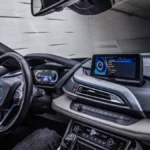As the automotive industry evolves, the need for enhanced car security is more pressing than ever. With increasing vehicle thefts and the rise of sophisticated hacking techniques, traditional car security methods are proving to be inadequate. Enter biometric technology—a game changer that is revolutionizing car security by using unique biological traits to ensure that only authorized individuals can access and operate vehicles. This article explores how biometric technology is making cars safer, the various types of biometric systems, and what the future holds for car security tech in the USA.
Understanding Biometric Technology in Car Security
Biometric technology involves using unique physical or behavioral characteristics to verify a person’s identity. In the context of car security, biometric systems can include fingerprint recognition, facial recognition, iris scanning, and voice recognition. These systems provide an added layer of security that is difficult to bypass, making unauthorized access to vehicles a daunting challenge for thieves.
Key Features of Biometric Technology in Cars

Here are some essential features that highlight the effectiveness of biometric technology in enhancing car security:
- Personalized Access Control
Biometric systems allow vehicles to recognize specific users based on their unique traits, ensuring that only authorized individuals can unlock and start the vehicle. - Enhanced Security Against Theft
Unlike traditional keys or fobs, which can be lost or duplicated, biometric data is unique to each individual, significantly reducing the risk of theft. - User Convenience
Drivers no longer need to fumble with keys or fobs. A simple touch, glance, or voice command can grant access, making the driving experience more seamless. - Data Analytics
Biometric systems can collect and analyze user data to provide insights into driving behavior and preferences, allowing for more personalized experiences. - Integration with Other Security Features
Biometric technology can work in conjunction with other car security tech, such as GPS tracking and alarm systems, for a comprehensive security solution.
Types of Biometric Technology Used in Cars
Several types of biometric systems are making their way into modern vehicles, each with unique advantages and applications:
1. Fingerprint Recognition
Fingerprint recognition systems scan the unique patterns of an individual’s fingerprints to grant access. This technology is becoming increasingly popular in luxury vehicles and is known for its speed and reliability.
- Advantages:
- Fast and easy to use.
- High accuracy and low false acceptance rates.
- Disadvantages:
- Requires maintenance to ensure sensor cleanliness.
- Potential issues with wet or dirty fingers.
2. Facial Recognition
Facial recognition technology analyzes the unique features of a person’s face, allowing for hands-free access to the vehicle.
- Advantages:
- No physical contact required.
- Can include additional safety features, such as driver monitoring for fatigue.
- Disadvantages:
- Sensitive to changes in appearance (glasses, facial hair).
- Requires sufficient lighting for accurate scanning.
3. Iris Scanning
Iris scanning uses a camera to capture the unique patterns in an individual’s iris. This method offers a high level of accuracy and security.
- Advantages:
- Extremely difficult to replicate or spoof.
- High accuracy even in low-light conditions.
- Disadvantages:
- Requires specialized hardware.
- Can be more expensive to implement.
4. Voice Recognition
Voice recognition systems authenticate users based on their unique vocal characteristics, allowing for access through spoken commands.
- Advantages:
- Hands-free operation.
- Can integrate with other voice-activated features in the car.
- Disadvantages:
- Can struggle with background noise.
- Performance may vary based on health conditions affecting voice.
Table: Comparison of Biometric Technologies in Cars
| Biometric Type | Speed of Access | Security Level | Cost of Implementation | User Convenience |
|---|---|---|---|---|
| Fingerprint | Fast | High | Moderate | High |
| Facial Recognition | Moderate | High | High | High |
| Iris Scanning | Fast | Very High | High | Moderate |
| Voice Recognition | Fast | Moderate | Moderate | Very High |
Impact of Biometric Technology on Car Security
1. Reducing Vehicle Theft
Biometric technology significantly reduces the likelihood of vehicle theft. Traditional keys can be easily replicated or stolen, while biometric data is much harder to compromise. According to the National Insurance Crime Bureau (NICB), vehicle thefts have been on the rise, emphasizing the need for advanced security measures. Biometric systems create a barrier that most thieves cannot overcome, thus acting as a strong deterrent.
2. Enhancing Driver Safety
With features such as facial recognition and driver monitoring, biometric technology can help keep drivers safe. These systems can alert authorities if the driver shows signs of fatigue or distraction, potentially preventing accidents before they happen. Additionally, integrating biometric technology with existing safety features can create a holistic safety environment within the vehicle.
3. Personalization and Comfort
Biometric systems can tailor the driving experience based on the identified driver. For example, once the system recognizes a specific driver, it can automatically adjust the seat position, climate controls, and entertainment preferences. This level of personalization enhances comfort and convenience, making each drive more enjoyable.
Challenges and Considerations
While biometric technology offers numerous advantages, it also presents challenges that manufacturers and consumers must address:
1. Privacy Concerns
The collection and storage of biometric data raise significant privacy issues. Manufacturers must implement robust security measures to protect this sensitive information from breaches and unauthorized access.
2. Cost of Implementation
High-quality biometric systems can be expensive to develop and implement. This cost may affect the overall pricing of vehicles, potentially making them less accessible to some consumers.
3. Technical Limitations
Biometric systems are not foolproof. Factors like environmental conditions, changes in user appearance, and technological malfunctions can affect performance. Ensuring reliability across different scenarios is crucial for widespread adoption.
The Future of Biometric Technology in Cars
The integration of biometric technology into car security is only expected to grow. Here are some trends to watch for:
1. Increased Adoption in Mainstream Vehicles
While luxury brands currently lead the way, expect more mainstream manufacturers to incorporate biometric systems into their vehicles. As technology advances and costs decrease, these systems will become more widely available.
2. Advanced AI Integration
The incorporation of artificial intelligence with biometric technology can lead to more intelligent systems capable of learning user behavior and preferences over time. AI can enhance the accuracy of biometric identification and enable predictive features for a more personalized driving experience.
3. Regulatory Standards and Compliance
As biometric technology becomes more prevalent, regulatory standards for data protection and privacy will likely emerge. Manufacturers will need to comply with these regulations to ensure user trust and safety.
FAQs About Biometric Technology in Car Security
1. How does biometric technology improve car security?
A: Biometric technology enhances car security by using unique physical characteristics, such as fingerprints or facial recognition, to ensure that only authorized users can access the vehicle, significantly reducing the risk of theft.
2. Are biometric systems reliable?
A: While no system is entirely foolproof, biometric systems have proven to be highly reliable when properly implemented, with low false acceptance rates and strong security measures.
3. Can biometric systems be hacked?
A: Although biometric systems are more secure than traditional keys, they are not immune to hacking. Ensuring robust cybersecurity measures and regular updates is essential to mitigate risks.
4. What happens if the biometric system fails?
A: Most biometric systems are designed with backup access methods, such as a traditional key or pin code, to ensure users can still access their vehicles if the system fails.
5. How do I know if my car has biometric security features?
A: Check your vehicle’s specifications and features list. Many manufacturers advertise biometric technology as part of their car security offerings, especially in newer models.
Conclusion
Biometric technology is paving the way for a new era in car security, making vehicles safer and more convenient for drivers. As this technology continues to develop, we can expect even more innovative features that enhance security and personalization. By adopting biometric systems, consumers can enjoy the peace of mind that comes with knowing their vehicle is secure from theft and unauthorized access.
The future of car security tech in the USA looks promising, with biometric technology leading the charge. Embracing these advancements not only protects vehicles but also enhances the overall driving experience, creating safer roads for everyone.








